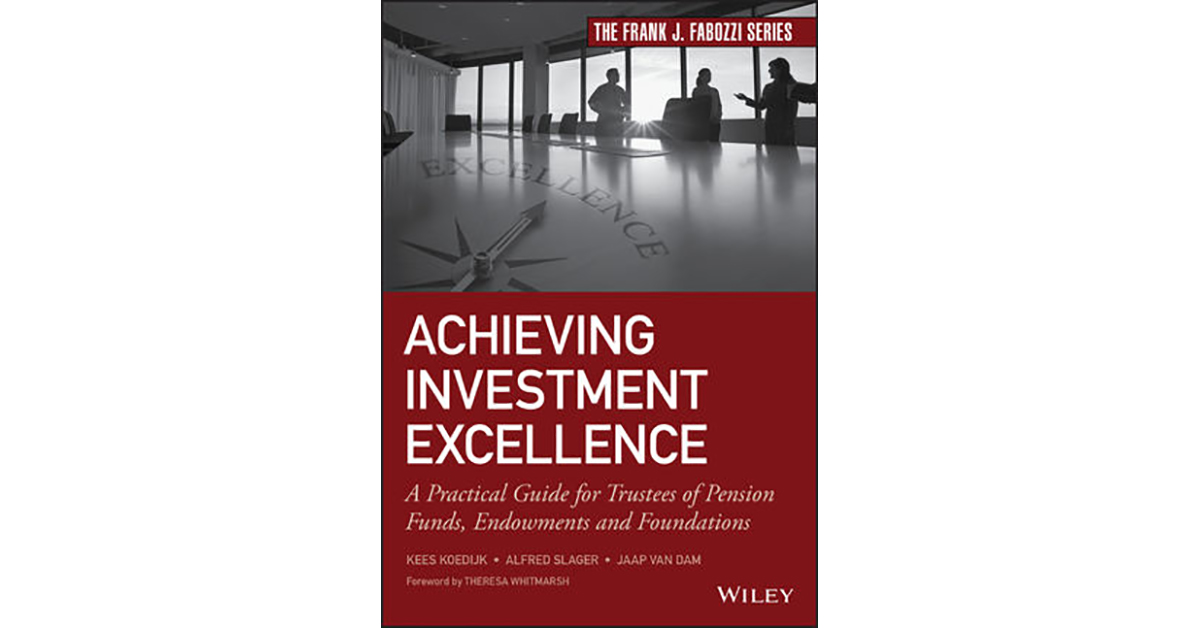[ad_1]
Achieving Investment Excellence: A Practical Guide for Trustees of Pension Funds, Endowments and Foundations. 2019. Kees Koedijk, Alfred Slager, and Jaap van Dam. John Wiley & Sons.
Most investment books focus on portfolio management and asset allocation. Little effort is directed toward understanding the governance of pension funds and endowments, yet pension oversight — the relationship between trustees and portfolio managers as agents of the board — is critical to performance success. A well-trained financial professional with poor trustees will be hamstrung and likely unsuccessful. An average portfolio manager with a high-quality board fully engaged with its fiduciary responsibilities will likely produce good long-term performance. Trustees need to understand and appreciate their duties to all stakeholders and finance professionals who work for pension plans and endowments need to understand how to manage their trustee relationships.
Achieving Investment Excellence is a comprehensive guide to
the roles and responsibilities for trustees and board members that focuses on
the practical aspects of pension governance. The authors, experienced European
academics and investment practitioners, walk through all of the requirements
for being a successful trustee and creating an effective board that fully
addresses stakeholder needs. Trustees are not portfolio managers, but their
oversight and guidance provide the necessary direction for effective
management.
Kees Koedijk, Alfred Slager, and Jaap van Dam provide a roadmap that will make any trustee and board more effective. The book is divided into five key sections: the role and mission of pensions, designing the process, implementing the investments, organizing the board, and learning how to adapt in a changing world. Each chapter starts with a short list of key takeaways, shows clear graphics to describe key concepts, and ends with case studies on how major organizations have dealt with critical issues and concepts. This book is the text for a master class on trustee management and pension governance.
A pension plan’s role and
mission may seem simple, yet the authors describe a number of key topics that
should be driven by the board. These topics include the responsibilities of all
parties involved in the process and defining the core mission. If a pension’s
mission is not well understood, investment choices may be at odds with
institutional goals. The mission entails more than just outlining liabilities
or setting minimum returns.
An endowment’s design process requires trustees to grasp not only classic investment essentials, such as return and risk, but also key choices — between conventional and alternative assets, active versus passive management, styles and factor betas — and socially responsible investing. The authors touch on all of these important concepts, although further elaboration would have been helpful for drawing distinctions. Trouble always awaits trustees who do not appreciate that low volatility is not the same as low risk or that there is a clear price for risk.
The authors highlight the key issue of investment beliefs as a basis for setting direction. If trustees have no philosophy or set of core beliefs about how markets operate, they will be easily swayed by investment fads and fashions. The authors emphasize the importance of beliefs as guiding principles, framing such central investment questions as, for example, whether a pension plan should focus on active management or cost containment and indexing.
The investment chapter
reviews the models available to pension plans and endowments. Boards can choose
from traditional asset allocation, the endowment model, or a factor allocation
model, as well as an opportunity cost, operational benchmark, or risk parity
model. Each has pros and cons, along with different sets of responsibilities
and costs. These critical choices for trustees working with management must be
consistent with core beliefs. As the authors point out, the endowment model may
work for Yale University, but that does not mean it will work for all
endowments; in some cases, it may be exactly the wrong choice.
Implementation of investment strategy leads to a host of trustee oversight topics addressed in the book. The authors review managing costs, manager selection, monitoring and evaluation, and the role of the board. The cases in this section discuss why implementing a strategy is not easy and requires extensive, clear communication between the board and management.
The fourth section reviews the organization and composition of the board, new board appointments, and the necessary components for forming an effective board. Boards should not attempt to be portfolio managers, but they can play an active role in enhancing performance through their oversight. The final section discusses how trustees need to be active learners who take advice and the practical steps toward achieving investment excellence.
Given their deep experience
and background, the authors could have offered stronger opinions on what works
and fails. Instead, they focus on general best practices with alternatives.
They also could have spent more time developing the topics of liability
management, underfunding, determining the correct discount rate, the balance
between liquid and illiquid investments, and meeting minimum cash flows.
Exploring all of these items, however, would have made for a much longer book.
The authors do focus on the critical question of governance through a dynamic,
learning board, and if trustees follow the book’s prescription, they should
have a suitable framework for tackling these other issues.
Serving on several investment boards for small endowments and working with a number of pension plans of varying size and sophistication, I have observed wide variation in levels of skill, oversight, and knowledge. Trustee skill can have a huge impact on how the portfolio handles change, serves stakeholders, and copes with crises. All parties will benefit from having all trustees or board members study this book as part of their responsibilities. Managers should have it on their shelves to help understand the role of trustees and boards and to manage the organization effectively.
For more on this topic, don’t miss Investment Trustees: Understanding Investment Committee Responsibilities by Jeffery V. Bailey, CFA, and Thomas M. Richards, CFA, from the CFA Institute Research Foundation.
If you liked this post, don’t forget to subscribe to the Enterprising Investor.
All posts are the opinion of the author. As such, they should not be construed as investment advice, nor do the opinions expressed necessarily reflect the views of CFA Institute or the author’s employer.
[ad_2]
Image and article originally from blogs.cfainstitute.org. Read the original article here.



